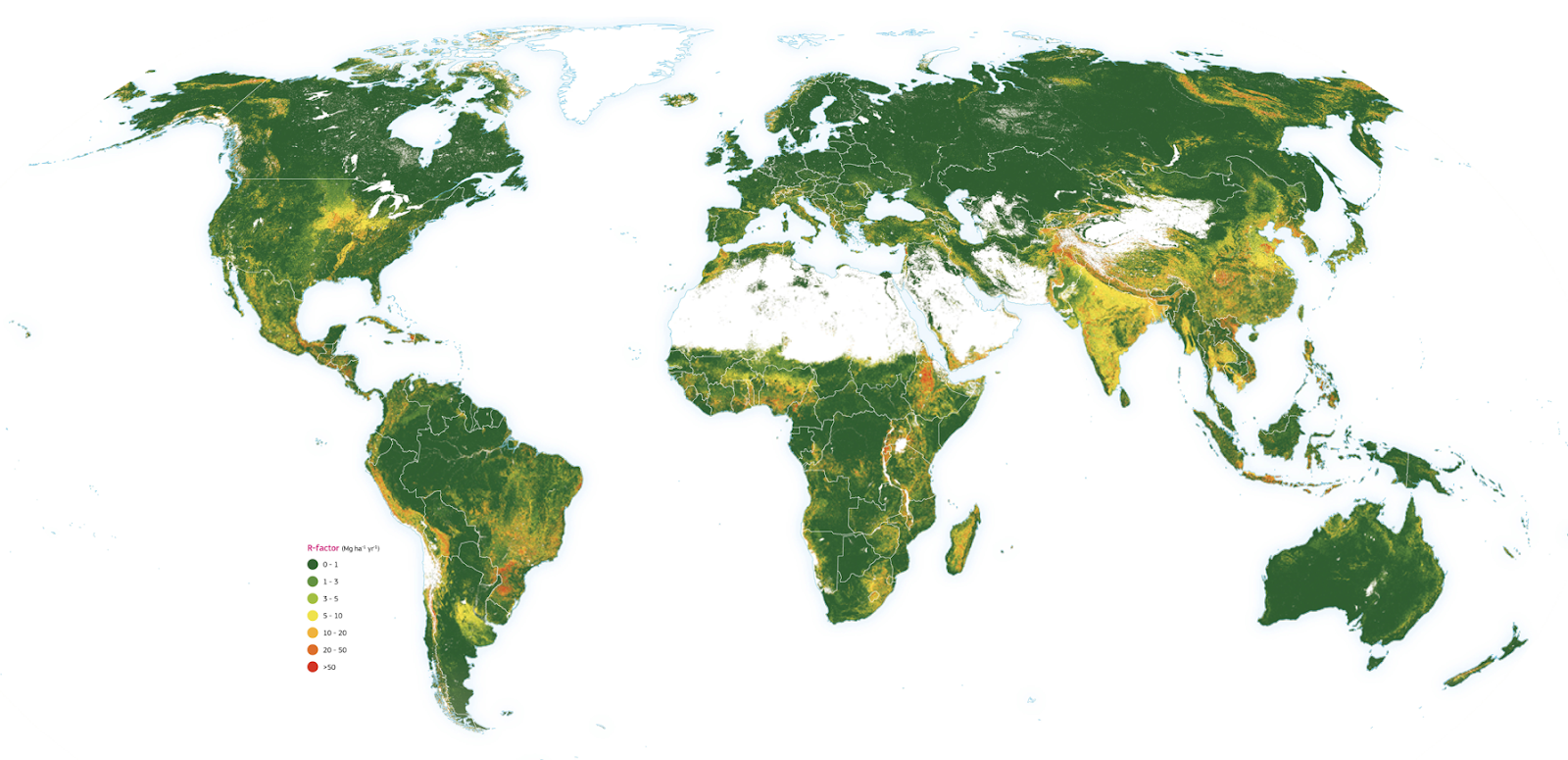This is the second article in an eight-part series to be published by GAI News that will examine the eight existing trends that are set to alter the structure of our global food system. Join us each month for a new installment, and see the first article here.
By Jeremy Stroud, Bonnefield Agricultural Investment Analyst, and Michael DeSa of AGD Consulting
“The nation that destroys its soil destroys itself.” – F.D. Roosevelt
The oft-imagined idea of fertile, pristine farmland as far as the eye can see is drifting towards the past. Land loss is more than just a blow to those who ![]() grasp on to a pastoral ideal of the countryside; rather it marks a shift in the global supply dynamics of land resources. The literature presents a singular case: more topsoil is removed from production than is added, with some academics estimating a reduction of about 1 percent each year[1].
grasp on to a pastoral ideal of the countryside; rather it marks a shift in the global supply dynamics of land resources. The literature presents a singular case: more topsoil is removed from production than is added, with some academics estimating a reduction of about 1 percent each year[1].
Healthy topsoil is home to billions of thriving micro-organisms which allow crops to be optimally produced. As the topsoil is physically eroded or disrupted, its biological matter also declines, and therefore its capacity to produce optimal yields is compromised.
Land scarcity is not a new concept, although with the level of impact it is expected to have on society, it is a topic that deserves more discussion. In the first article of this series, we discussed the effects of urbanization on the global agricultural system. This commentary will examine another piece of the farmland usage puzzle and its impact on our collective accessibility to food: land degradation and soil erosion.
Land degradation refers to human-derived processes which lead to the decline in ecosystem functions[2]. It manifests itself in three different forms:
physical: compaction, desertification, and soil erosion (which is the largest contributor to productivity loss)
chemical: soil acidification and salinization
biological: soil organic matter reduction and loss in biodiversity
Farmers work in different ways to combat chemical and biological forms of land degradation, although the most persistent and arguably the most difficult to mitigate of these, is physical degradation of topsoil. While usually considered as a local concern, soil erosion, compaction and other types of land degradation are globally consequential issues and evidence suggests they will have direct implications for the world’s food supply.
The Inter-Governmental Science-Policy Platform on Biodiversity and Ecosystem Services (IPBES) is widely considered the international authority on bio-ecological matters[3]. The organization recently concluded a three-year study analyzing the status of global land and soil quality, which collected insights from over 100 of the world’s leading subject experts. They found that approximately 3.2 billion people, or nearly 43 percent of the world’s population, experience negative economic impacts from land degradation in industries varying from agriculture to tourism, to mining[4]. The effects of land degradation are expected to accelerate in magnitude as the degree of high-volatility weather systems increase[5].
The Causes and Status of Land Degradation Globally
Erosion takes place when soil is left uncovered and the particles are washed or blown away. Heavy downpours, surface water ponding, intensive land use and mechanical human activities are continuing to reduce topsoil – particularly in the most intensively farmed regions. For example, China and India are losing topsoil at three to four times the rate of North America[6]. Land erosion and degradation also occurs due to tillage, deforestation, and an increase in rainfall intensity. One study indicates that there has been a 53 percent increase in the number of extreme rainfall days recorded globally over the past 30 years, thereby leading to record levels of erosion and runoff[7].
In the past 20 years, a greater proportion of rainfall has arrived in the form of extreme single-day weather events than has ever been recorded. Figure 1 demonstrates the percentage of land area in the contiguous United States affected by extreme precipitation in each year as reported by the National Oceanic and Atmospheric Administration. The orange line represents a nine-year trailing average, highlighting a significant fact for soil erosion: the average percentage of US land affected by extreme one-day rain events has increased from 7 percent in the 1970’s to 18 percent in 2015.
Figure 1: Extreme One-Day Weather Events in the Contiguous United States, 1910-2015[8]

Erosion naturally leads to further soil compaction, nutrient degradation and impaired water drainage, which reduces the overall productive capacity of the land. With nearly 60 percent of the world’s farmland considered degraded, our arable land base is steadily declining[9].
Figure 2 demonstrates where the greatest soil erosion concerns are expected to occur in the future based on a detailed joint study by the European Commission and the University of Basel. The R-factor is the rainfall-runoff erosivity factor, or an annual summation of erosion index (EI) values (erosion force of rainfall) in a normal year’s rain.
Figure 2: The Geo-Spatial Pattern of Soil Erosion, 2018[10]

Opportunity Amidst the Loss
As soil degradation increases the scarcity of fertile land, it also creates the need to incorporate sustainable farm management practices and pursue responsible investment goals. Farmland investors and stakeholders should consider five primary categories in their path to mitigate soil erosion effects and potentially reap the upside potential that follows:
1.) Deal Sourcing & Region Identification: Investors should look to identify farming regions with topsoil abundance, low wind and flood risk, and relatively flat or rolling terrain. Investment teams have the responsibility to review an area’s historical and forecasted climatic risks in advance of deal selection. This includes past precipitation and temperature averages, available soil and yield mapping data, historical input usage, previous environmental issues and/or remediation measures. Investors may also want to consider geographic regions that successfully practice no-till land preparation, such as Argentina, Australia, and Canada.
2.) Due Diligence: Most farmland asset managers should be able to leverage geo-spatial information data and measurement tools to determine how past farm imagery compares to the current status of the field. It is also worthwhile to consider warning signs such as noticeable compaction, dispersed ponding, and natural drainage flows.
3.) Sustainable Farm Management Practices: Farm operators have the opportunity to replenish topsoil quality through the implementation of practices such as no-till and low-till farming, as well as the regular use of green manure crops to enhance soil biodiversity, structure, and to replenish nutrients. Further, integrated pest management (IPM) plans leveraging biological and mechanical processes can control pests while reducing chemical pesticide use.
4.) Investment in Loss Prevention & Restoration: Capital expenditure in ditching, tile drainage, external tree-borders, berms, and riparian-buffer maintenance can control soil erosion effects while also mitigating natural disaster risks such as flooding, wind damage, and surface ponding. For permanent and specialty crop strategies, the implementation of technology and products offered by groups like the Land Life Company – a startup that is working to restore ecosystems in degraded soil regions through reforestation efforts – should be considered CapEx well spent.[14]
5.) Long-term Tenure Mindset: Investors who plan to own and/or operate farmland for the long-term will be naturally incentivized to adopt sustainable land management practices which can promote the health and productivity of soil. Farmland owners should be cautious of short-term (less than three year) lease structures which may create the risks of nutrient mining or high-intensity agricultural practices.
With land degradation on the rise, the tools to reduce soil loss and protect these investments are slowly becoming more available and adoptable. As soils from intensive agricultural regions continue to deplete, we hypothesize that land managed with sustainable practices shall prove to be significantly more valuable in the decades to come.
Continue Reading:
Part III – Lessons in Consumption: Fresh Water Scarcity and Agriculture’s Reliance on Irrigation
ABOUT THE AUTHORS:
PRIMARY AUTHOR
 Jeremy Stroud is an agricultural investment analyst with Bonnefield based in Toronto, Canada. With a background in international food business, he offers insights on global agri-food and water investments, value chain analysis and economic systems. His travels have brought him to over 50 countries – within which he has volunteered and worked with a spectrum of primary and vertically integrated agricultural businesses.
Jeremy Stroud is an agricultural investment analyst with Bonnefield based in Toronto, Canada. With a background in international food business, he offers insights on global agri-food and water investments, value chain analysis and economic systems. His travels have brought him to over 50 countries – within which he has volunteered and worked with a spectrum of primary and vertically integrated agricultural businesses.
CONTRIBUTING AUTHOR
 Michael DeSa is the founder/managing director of AGD Consulting, a U.S.-based, strategic advisory and business development firm servicing the agricultural and resource sectors in emerging and OECD markets. His agricultural engineering background, 10-years of project management experience with the U.S. Marine Corps, and agribusiness investment experience make him uniquely qualified to counsel companies throughout the region.
Michael DeSa is the founder/managing director of AGD Consulting, a U.S.-based, strategic advisory and business development firm servicing the agricultural and resource sectors in emerging and OECD markets. His agricultural engineering background, 10-years of project management experience with the U.S. Marine Corps, and agribusiness investment experience make him uniquely qualified to counsel companies throughout the region.
~~~~~~~~~~~~~~~~~~~~~~~~~~~~~~~~~~~~~~~~~~~~~~~~~~~~~~
SOURCES:
[1] Pimentel and Burgess, “Soil Erosion Threatens Food Production,” 2013
[2] IPBES, 2018
[3] IPBES, 2018
[4] IPBES, 2018
[5] IPBES, 2018
[6] David Pimentel, as quoted in a Cornell University Article, 2006
[7] Dourte et al., Climate Risk Management Journal, 2015
[8] National Oceanic and Atmospheric Administration, 2016
[9] Stanford University Course on Topsoil Loss, 2015
[10] European Commission Joint Research Centre, World Atlas of Desertification, 2018
[11] European Commission Joint Research Centre, University of Basel and Centre for Ecology & Hydrology, 2017
[12] European Commission Joint Research Centre, World Atlas of Desertification, 2018
[13] Jeremy Grantham, The Race of Our Lives: Revisited, 2018
[14] Land Life Company, 2019
